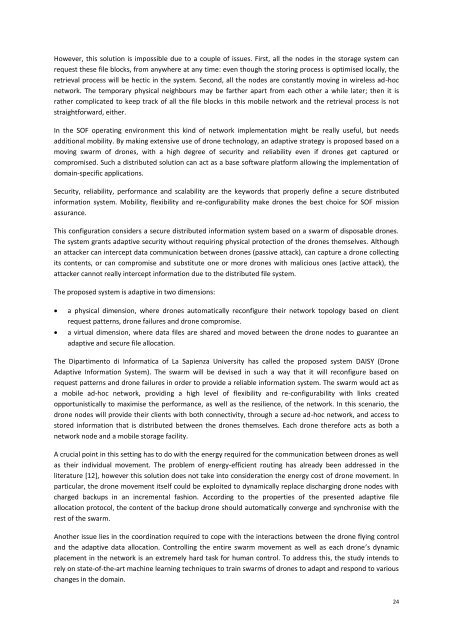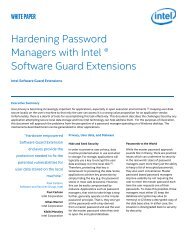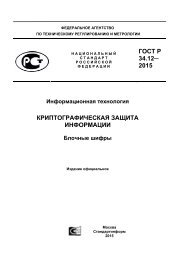BATTLEFIELD DIGITAL FORENSICS
BDF_Battlefield_Digital_Forensics_final
BDF_Battlefield_Digital_Forensics_final
Create successful ePaper yourself
Turn your PDF publications into a flip-book with our unique Google optimized e-Paper software.
However, this solution is impossible due to a couple of issues. First, all the nodes in the storage system can<br />
request these file blocks, from anywhere at any time: even though the storing process is optimised locally, the<br />
retrieval process will be hectic in the system. Second, all the nodes are constantly moving in wireless ad-hoc<br />
network. The temporary physical neighbours may be farther apart from each other a while later; then it is<br />
rather complicated to keep track of all the file blocks in this mobile network and the retrieval process is not<br />
straightforward, either.<br />
In the SOF operating environment this kind of network implementation might be really useful, but needs<br />
additional mobility. By making extensive use of drone technology, an adaptive strategy is proposed based on a<br />
moving swarm of drones, with a high degree of security and reliability even if drones get captured or<br />
compromised. Such a distributed solution can act as a base software platform allowing the implementation of<br />
domain-specific applications.<br />
Security, reliability, performance and scalability are the keywords that properly define a secure distributed<br />
information system. Mobility, flexibility and re-configurability make drones the best choice for SOF mission<br />
assurance.<br />
This configuration considers a secure distributed information system based on a swarm of disposable drones.<br />
The system grants adaptive security without requiring physical protection of the drones themselves. Although<br />
an attacker can intercept data communication between drones (passive attack), can capture a drone collecting<br />
its contents, or can compromise and substitute one or more drones with malicious ones (active attack), the<br />
attacker cannot really intercept information due to the distributed file system.<br />
The proposed system is adaptive in two dimensions:<br />
<br />
<br />
a physical dimension, where drones automatically reconfigure their network topology based on client<br />
request patterns, drone failures and drone compromise.<br />
a virtual dimension, where data files are shared and moved between the drone nodes to guarantee an<br />
adaptive and secure file allocation.<br />
The Dipartimento di Informatica of La Sapienza University has called the proposed system DAISY (Drone<br />
Adaptive Information System). The swarm will be devised in such a way that it will reconfigure based on<br />
request patterns and drone failures in order to provide a reliable information system. The swarm would act as<br />
a mobile ad-hoc network, providing a high level of flexibility and re-configurability with links created<br />
opportunistically to maximise the performance, as well as the resilience, of the network. In this scenario, the<br />
drone nodes will provide their clients with both connectivity, through a secure ad-hoc network, and access to<br />
stored information that is distributed between the drones themselves. Each drone therefore acts as both a<br />
network node and a mobile storage facility.<br />
A crucial point in this setting has to do with the energy required for the communication between drones as well<br />
as their individual movement. The problem of energy-efficient routing has already been addressed in the<br />
literature [12], however this solution does not take into consideration the energy cost of drone movement. In<br />
particular, the drone movement itself could be exploited to dynamically replace discharging drone nodes with<br />
charged backups in an incremental fashion. According to the properties of the presented adaptive file<br />
allocation protocol, the content of the backup drone should automatically converge and synchronise with the<br />
rest of the swarm.<br />
Another issue lies in the coordination required to cope with the interactions between the drone flying control<br />
and the adaptive data allocation. Controlling the entire swarm movement as well as each drone’s dynamic<br />
placement in the network is an extremely hard task for human control. To address this, the study intends to<br />
rely on state-of-the-art machine learning techniques to train swarms of drones to adapt and respond to various<br />
changes in the domain.<br />
24





